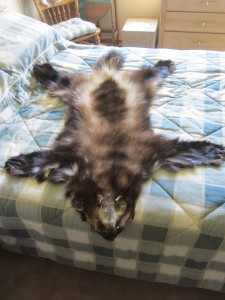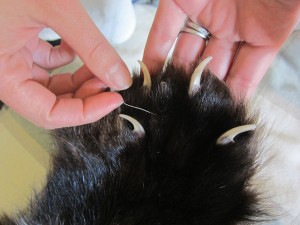Our next stop is to visit Mark’s Aunt Maureen and Uncle Don. They recently moved to Richland, WA from Spokane, for the warmer climate and to live closer to family.
Don is a “river doctor”, and travels all over North and South America helping rivers to flow in deliberate ways relative to development. He and Maureen often take off for months at a time and drive to far-flung places to work on sites.
Much of Don’s work has taken him into Canada, and into the Northwest Territories. One very unusual souvenir from their travels is a wolverine pelt. We’d never seen a wolverine, an animal known to be secretive, bad-tempered and a vicious fighter. This makes it an unlikely animal to see in a zoo :^) If you’ve ever read Jack London’s White Fang (required reading around 7th grade), you might remember learning about them, as White Fang’s mother scares one away from the den.
This wolverine pelt had a history. First Nations people are permitted to hunt wolverines in the Northwest Territories. Don and Maureen bought this wolverine pelt from a First Nations man in Fort McPherson, a town of 800 located well above the Arctic Circle, not far south of the Beaufort Sea and the Arctic Ocean. They arranged for a special permit to be able to bring the pelt into the U.S., and finally received it at home a few months after their trip.
The wolverine is also called a “skunk bear” because of its distinctive striped markings; however, it is NOT a bear, it is the largest member of the mustelid family (otters, weasels, etc.). The pelt’s fur is long and thick, and soft to the touch. It is beautiful. The claws are still attached too, and they are long, curved and sharp. Definitely not the kind of claws you would want to see coming at you while still attached to an annoyed live wolverine.
It is a little strange to see pelts in people’s homes. This animal was hunted by a local, someone whose ancestors likely hunted wolverines for the thick, warm fur they provided. And now the First Nations people are allowed to hunt a few hundred each year, and the sale of the pelts supports their livelihood.
It is interesting to travel away from our own coast and mindset, and enter a part of the world where animals are hunted as much for livelihood as for sport. After leaving Don & Maureen, we travel further east to stay with Mark’s Aunt Caroline and Uncle Bob, and delve deeper into the game lifestyle of rural Idaho, where I’m fairly certain calling someone a “vegetarian” is viewed as an extreme insult.

